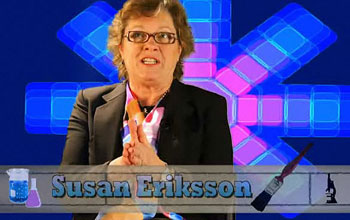News Release 09-174
The Art of Science
Geologist Susan Eriksson explores creative ways to fuse art and science
September 17, 2009
This material is available primarily for archival purposes. Telephone numbers or other contact information may be out of date; please see current contact information at media contacts.
Exploring creative ways to fuse art and science comes naturally for Susan Eriksson, geologist and artist, who is director of education and outreach for a Boulder-based geophysics organization funded by the National Science Foundation and NASA.
"People recognize that artists are creative, and I think that talking about art and science gives me a floor to say that science is creative too," said Eriksson.
Eriksson observes how art, like science, requires a thought process that challenges the individual to contemplate his or her designs and discover which ones are most effective. Eriksson explained that this process does not happen overnight, and her end goal is to "put something out there that will make people think a little bit."
Using materials that range from metal to wood to minerals, Eriksson creates unique pieces that are often inspired by the geological world. She explained how landscapes lend themselves to "beautiful juxtaposition of space-negative space and positive space."
In physically working with her materials, Eriksson observed how scientific concepts are used in creating her art. For instance, quantitative skills are used to divide tonal systems, and metal work incorporates various chemistry principles.
At the heart of art and science lies the ability to explore the world around us.
"All science is really beautiful; that's why we become scientists. We enjoy the wonder of it, we enjoy the intricacy of it, how complicated it is. It's just so fascinating, and I think art's the same way," Eriksson said.
The Art of Science (AoS) Project
The Art of Science Project was created by a cross-directorate committee of NSF staff. The committee is on a volunteer basis and strives to bring original works to NSF that visually reflect the connections between art and science.
For more information contact a current member of the AoS committee via email at AoS@nsf.gov.
-NSF-
Media Contacts
Dana Topousis, National Science Foundation, (703) 292-8070, email: dtopousi@nsf.gov
Related Websites
Susan Eriksson Web Page: http://susaneriksson.info/
The U.S. National Science Foundation propels the nation forward by advancing fundamental research in all fields of science and engineering. NSF supports research and people by providing facilities, instruments and funding to support their ingenuity and sustain the U.S. as a global leader in research and innovation. With a fiscal year 2023 budget of $9.5 billion, NSF funds reach all 50 states through grants to nearly 2,000 colleges, universities and institutions. Each year, NSF receives more than 40,000 competitive proposals and makes about 11,000 new awards. Those awards include support for cooperative research with industry, Arctic and Antarctic research and operations, and U.S. participation in international scientific efforts.
Connect with us online
NSF website: nsf.gov
NSF News: nsf.gov/news
For News Media: nsf.gov/news/newsroom
Statistics: nsf.gov/statistics/
Awards database: nsf.gov/awardsearch/
Follow us on social
Twitter: twitter.com/NSF
Facebook: facebook.com/US.NSF
Instagram: instagram.com/nsfgov



